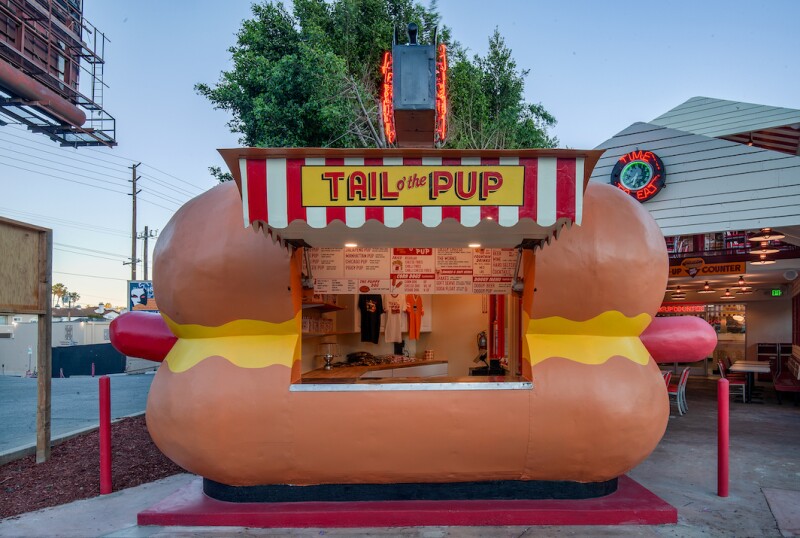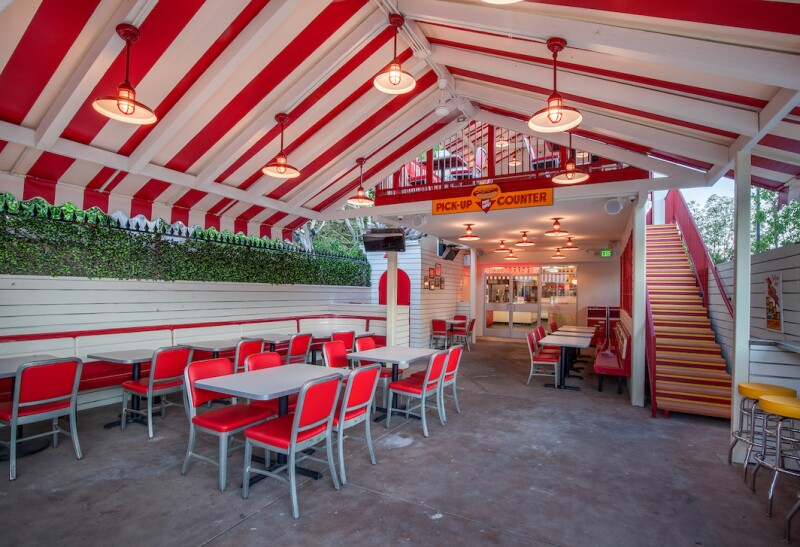When people think of Los Angeles, they might imagine rows of palm trees lining wide boulevards, the gleam of the Hollywood sign glinting off the mountainside, or the stately rotunda of the Griffith Observatory. For some, however, the thing that defines L.A. for them is a bit more humble—it’s a hot dog stand.
Known as the Tail O’ the Pup, the legendary hot dog–shaped restaurant beloved by celebrities, locals, and tourists alike, has been a part of the city’s identity and pop culture history ever since it opened its doors in 1946. Though it shuttered its ordering window in 2005, the Pup is now under new ownership and making dogs once again beginning on July 20, National Hot Dog Day.
Spanning 18 feet and made out of stucco, the Tail O’ the Pup was designed in 1939 by streamline moderne architect Milton J. Black for celebrity ballroom dance couple Veloz and Yolanda Casazza, who dreamt of opening a restaurant. When World War II broke out, the waltzing lovebirds decided to put their hot dog dreams on hold until after the war ended. In 1946, the Pup finally opened its doors and was an almost immediate hit thanks to its eye-catching shape. It was especially popular among the patrons of Kiddieland Beverly Park (an old theme park that was sited where the Beverly Center is today), located across the street.
After 30 years of business, the Pup was sold to Eddie Blake in 1976, who ran the stand until it closed in 2005. Blake saw the restaurant through its golden years when celebrities like Betty White, Andy Warhol, Jay Leno, Sigourney Weaver, and bands like the Go-Gos frequented the stand. The legendary weenie has also been featured in countless Hollywood flicks and series, including Columbo, L.A. Story, and even The Muppets.

Because of its fun and eye-catching shape, the Tail O’ the Pup immediately became an L.A. icon upon opening.
Photo by Craig Aurness
After sitting in storage for a few years, the Tail O’ the Pup was acquired in 2018 by preservation-focused hospitality team the 1933 Group, which is responsible for successfully (and beautifully) restoring a number of historic locations around the city. Some of their works include the Highland Park Bowl bowling alley, the barrel-shaped Idle Hour in North Hollywood, and the Formosa Cafe in West Hollywood.
In order to get the Tail O’ the Pup back into shape, the group sympathetically restored the stucco dog, a process that involves addressing any structural issues of a building while staying true to its original physical appearance and history. The Pup has been painted differently five times over its existence, and the 1933 Group chose a palette during restoration that they felt most accurately reflected its original hues.
The Tail O’ the Pup was originally located at La Cienega and Beverly Boulevard and has shifted sites throughout the years. Its new location is permanent, thanks to its attached A-frame building, near the busy intersection of San Vicente and Beverly in West Hollywood. In addition to the stand, there’s now an eating area in the back that houses plentiful booth seating as well as the kitchen. The new space has had its own brush with fame: Most famously, The Doors recorded their final studio album L.A. Woman in 1971 when it was being used as a recording studio.
Co-owner Bobby Green feels he has a special connection to the Pup—it was one of the first “L.A.” things he saw when he visited the city initially with his family when he was 10 years old before moving to the city to work as a child actor. “One of the only things I really remember seeing is a giant hot dog,” Green says. “You know, you’re a kid, and you see this giant hot dog on the side of the road. That’s kind of hard to forget.”
Extensive research was done to create the Pup’s modern menu, and both the original menu from ’46 and offerings in ’76 were considered—after all, the restaurant once had a reputation for serving some of the best dogs in the city. The 1946 Pup features a split hot dog smothered with grilled onions and mustard. It’s a sandwich with a grown-up flavor profile that delivers a sweet, savory flavor explosion via an ultra-soft and pillowy bun.
The 1976 Pup is perhaps the simplest version of a hot dog on the menu: It consists of a steamed frank that’s been generously topped with ketchup and mustard. With no frills and no nonsense, the ’76 showcases the quality of the franks used at the Pup—they have a distinctive “snap” unique to Los Angeles–style hot dogs. There are also gluten-free corn dogs on the menu for the celiac crowd, Coney Island–style vegan dogs, and soft-serve ice cream with classic flavors like chocolate, vanilla, and a combo swirl—for an extra sweet treat, get your cone dipped in chocolate.

After sitting in storage for a few years, the Tail O’ the Pup was painstakingly restored to its former glory.
Courtesy of the 1933 Group
“We wanted to pay homage to the original menu, but we also wanted to feature the later menu and what everyone remembers,” Green says. “So then you’re left with the best of everything. The best of the ’70s and the best of the ’40s.”
The Tail O’ the Pup is a legendary example of programmatic architecture (also known as “novelty” and “mimetic” architecture), a style of construction popular in the 1920s and ’30s in Los Angeles characterized by buildings designed to look like what the businesses were selling: root beer stands shaped like barrels, chili restaurants located within bowl-like buildings, piano stores erected in the shape of grand pianos. Perhaps one of the most famous examples of programmatic architecture is Randy’s Donuts with its giant, oh-so Instagrammable rooftop doughnut.

The small building that’s now a part of the Tail O’ the Pup once served as a studio where The Doors recorded.
Courtesy of the 1933 Group
Los Angeles, however, doesn’t have a great record of valuing and preserving its historic buildings. Rather, the Southland has usually opted to demolish old constructions to make way for new developments. With projects like the restoration of the Tail O’ the Pup, Green hopes to preserve the yesteryear soul of Los Angeles that he fell in love with when he first came to the city as a kid. “The Pup is the welcoming mascot of Los Angeles,” Green says. “It says ‘Hey, welcome to L.A.; you’re not in Kansas anymore.’ It represents what Los Angeles is about—and we’re about being wacky, crazy, and different.”











